Here are some interesting maps that explain how one of the biggest empires in the world came to be and how it ceased to exist. The roman Empire was maybe huge and powerful at one point, but it started as a small city-state. The Romans conquered and ruled a vast territory for a long time, but then their empire crashed under its own weight.
1. Italy before the Roman conquest
It all started in 500 BC. Rome was just a small city-state on the Italian peninsula back then. In those early years, the Romans were just one of several tribes in Italy. The dominant group of people on the peninsula was the Etruscans. There is not a lot of information about these people, partly because their unique language is still not translated successfully. From the gathered evidence, we know that the city-state of Rome was ruled by Etruscan kings, up until the Roman revolt. This event happened in 509 BC and helped the Romans to create their own republic. Besides the Etruscans, there were other Latin-speaking tribes on the east of Rome. Also, there were some Greek settlements on the south of Italy.

2. Roman conquest of Italy
The city-state of Rome distinguished itself from the neighbors very soon. from 340 BC to 264 BC they managed to overpower the entire Italian Peninsula, and (as it turned out to be) this was only the beginning. Their conquest of Italy happened in three phases. The first to fall were their allies, the Latins. They were defeated in 338 BC. In 326 BC they started a war with their eastern neighbors, the Samnites. They managed to conquer them in 282 BC. At the same time, they were occasionally fighting with the Etruscans and Gauls on the North. After this, Rome faced the Greeks on the south of the peninsula. They entered in a war with the Greek king Pyrrhus. Pyrrhus did manage to win two battles against Rome (in 280 and 279 BC), but he lost many people in the battles and because of this, he lost the war. These events introduced the term “Pyrrhic victory” into the modern dictionary.
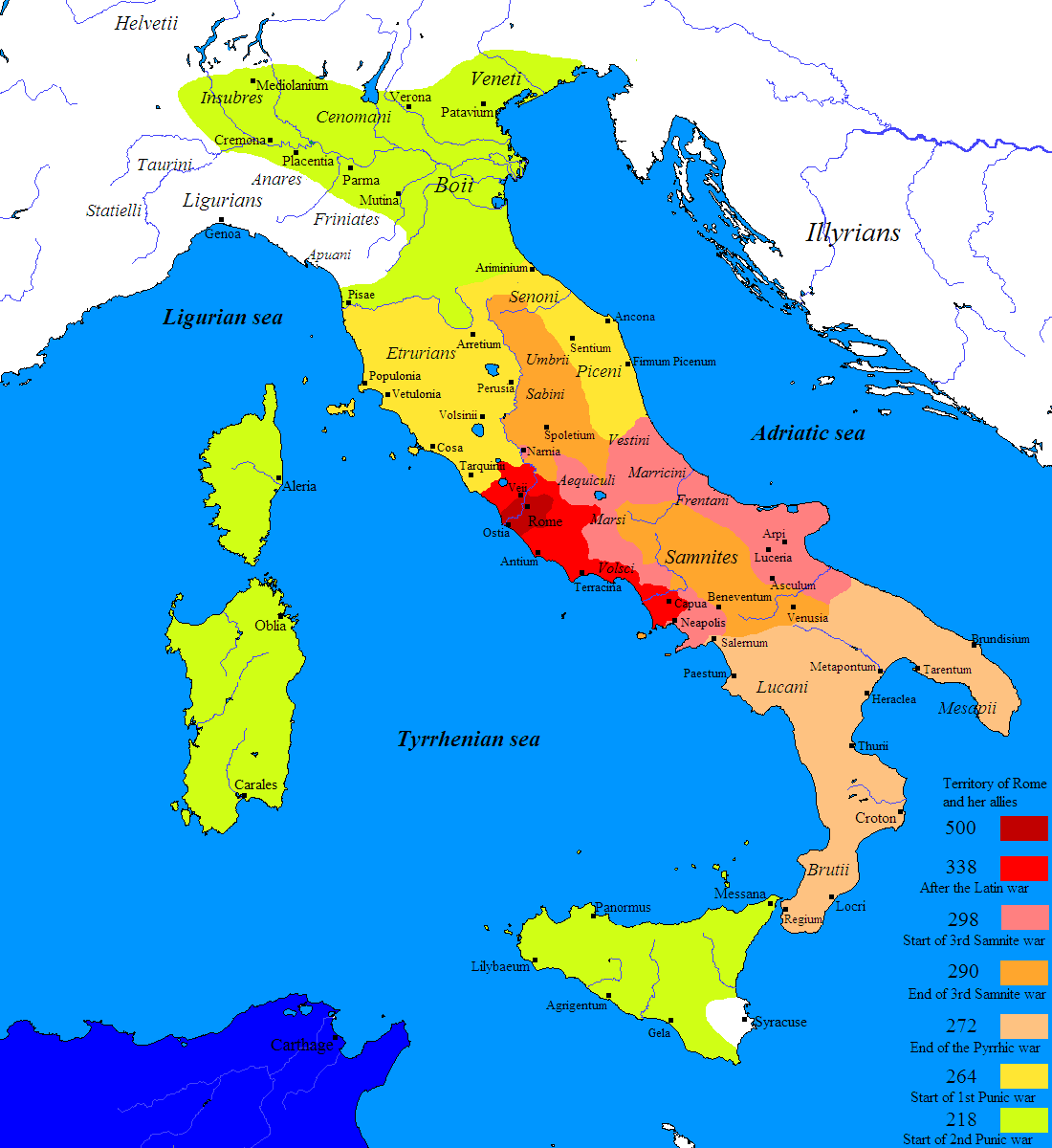
3. Hannibal’s attack on Rome
Hanibal, one of the greatest generals of the ancient world, was a Carthaginian born during the First Punic War. He despised the Romans because of the havoc they brought to his lands. That is why he decided to attack them in 218 BC. He gathered a huge army that even included a few dozen elephants and passed from Carthaginian-controlled Spain across the Alps to northern Italy. This started the second Punic War (war between Rome and Carthage). Hanibal hoped that his arrival would cause a rebellion that would end Roman control over Italy. But, he didn’t exactly managed to gather enough allies for this undertaking and Rome remained undefeated. Hannibal wasn’t able to capture Rome because the Romans managed to rebuild their army, destroyed in a previous encounter with him. After 15 years of endless skirmishes across Italy, Hanibal was called back to Carthage to help with the counterattack that the Romans prepared there. He lost the Battle of Zama in 202 BC and after this Rome strengthen its rule in Carthage, seizing all of their overseas possessions. After a Third Punic War, the whole Carthaginian civilization was destroyed and assimilated.
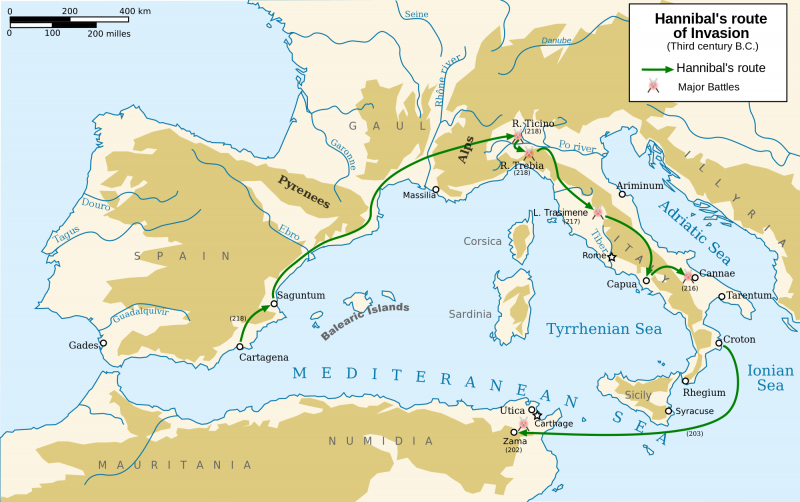
4. Julius Caesar and the conquering of Gaul
When Julius Caesar became the commander of the Roman forces on the northern frontier of Rome (in 58 BC), he decided that it is time to conquer Gaul. This land is basically the territory of modern-day France. Julius hoped that this action will strengthen his political position back home. Caesar’s campaign lasted for almost 10 years and he managed to gain control over almost every part of what is now considered as France. While he was on the battlefields, his political enemies managed to declare martial law in Rome. This meant that he needs to return home and deal with the situation. But if he returned as a citizen, without his army, he would be trialed for the acts of that he committed against Rome, before he went to Gaul. He needed his army, but Roman law didn’t allow a General on a campaign to enter the territory of Italy as the head of an army. Caesar decided to test his faith and crossed the river of Rubicon (northern border of Italy), together with his army. This is how he triggered the civil war that would reshape the Roman Republic.
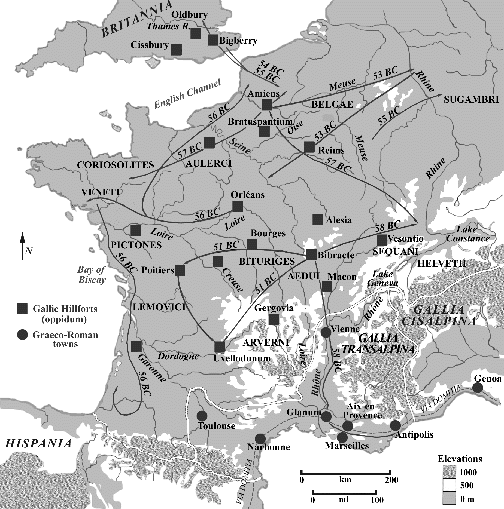
5. Augustus becomes Rome’s first emperor (Battle of Actium)
After Julius Caesar won the civil war, and after his assassination, there will be another war. A war between the two men who had strong claims for the Roman throne. One of them was Marc Antony (Caesar’s deputy) and the second was Caesar’s teenage grand-nephew, Octavian (adopted by Caesar posthumously, in his will). The two of them were on the same side at the beginning, fighting to avenge Caesar’s death. Later, Antony became involved with the beautiful Egyptian queen Cleopatra and this led to a war between him and Octavian. The map below shows the troop deployment during the Battle of Actium. The battle happened in 31 BC and it was crucial for determining the next ruler of Rome. Antony and Cleopatra were losing, they tried to escape Octavian’s forces by sea, but they were intercepted by Agrippa (Octavian’s deputy and navy commander). Agrippa won the battle, Antony and Cleopatra escaped, but they died a year later. This is how Octavian became the sole ruler of the roman throne and the whole Roman world. In 27 BC, he changed his name into Augustus. According to historians, this is the year when The Roman Republic became the Roman Empire.

6. Roman society was based on slavery
Slavery took a major part in the development of the Roman Empire. There were many ways that people could become slaves back then. When the battles were over, the remaining enemy survivors were often taken by the Roman victors and sold into slavery. People also became slaves because they weren’t able to pay their debts. Slavery was also punishment for many crimes. Roman slaves came from many different nations and they weren’t only doing manual labor or fought like gladiators. Some of them were highly skilled and worked as craftsmen. for example, educated slaves from the Hellenic lands were highly desired and usually worked as tutors for rich roman children. The slaves were aware of their situation and despised the way they’ve been treated, that is why many of them revolted. The most famous slave revolt (shown on the map) in Roman history was lead by a gladiator named Spartacus. He managed to gather an army of over 120,000 freed slaves and won many victories against the Romans. The rebellion was ultimately crushed and 6,000 slaves were crucified to serve as an example.
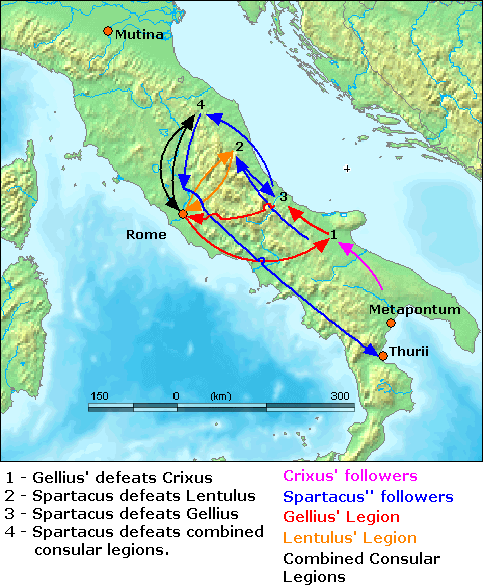
7. The spread of Christianity across the Roman Empire
Jesus Christ’s birthplace (Bethlehem), in the lands that belonged to the Jewish people, eventually became part of the Roman Province of Judea. This happened during the lifetime of Jesus. Christianity emerged in those years and gradually started spreading across the entire Roman Empire. The early Christians were in the same position as the Jew, they were under constant suspicion and surveillance from the Roman officials. It was like this because they were expected to make sacrifices for the emperor or for the Roman god, and this was considered as an act of blasphemy by the Christians. Christians were constantly persecuted, arrested and attacked, from the time of Emperor Nero in 64 AD, up until 313 AD. Nevertheless, Christianity continued to spread, as can be seen on this map.
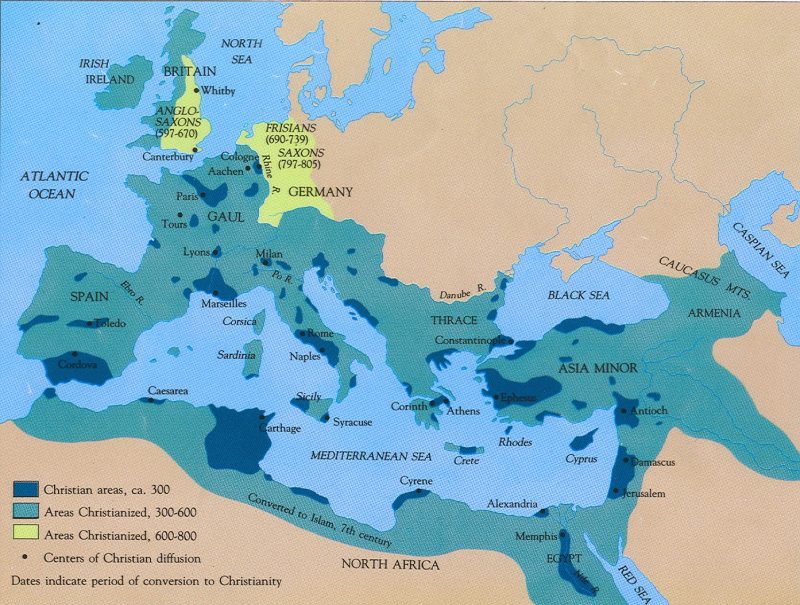
8. Roman conquest of Britain
Although Caesar was the first Roman that invaded Britain (in 55 BC), he didn’t establish a permanent Roman presence on the island. The official conquest of Britain started when emperor Claudius was on the Roman throne, in 43 AD. His military expedition lasted for almost 40 years and it covered the whole island, including the northernmost parts of Scotland. In reality, the roman troops only managed to conquer an area that can be measured by the territory of modern-day England and Wales. They managed to hold this land until 410 AD when the Western Roman Empire started to decline.
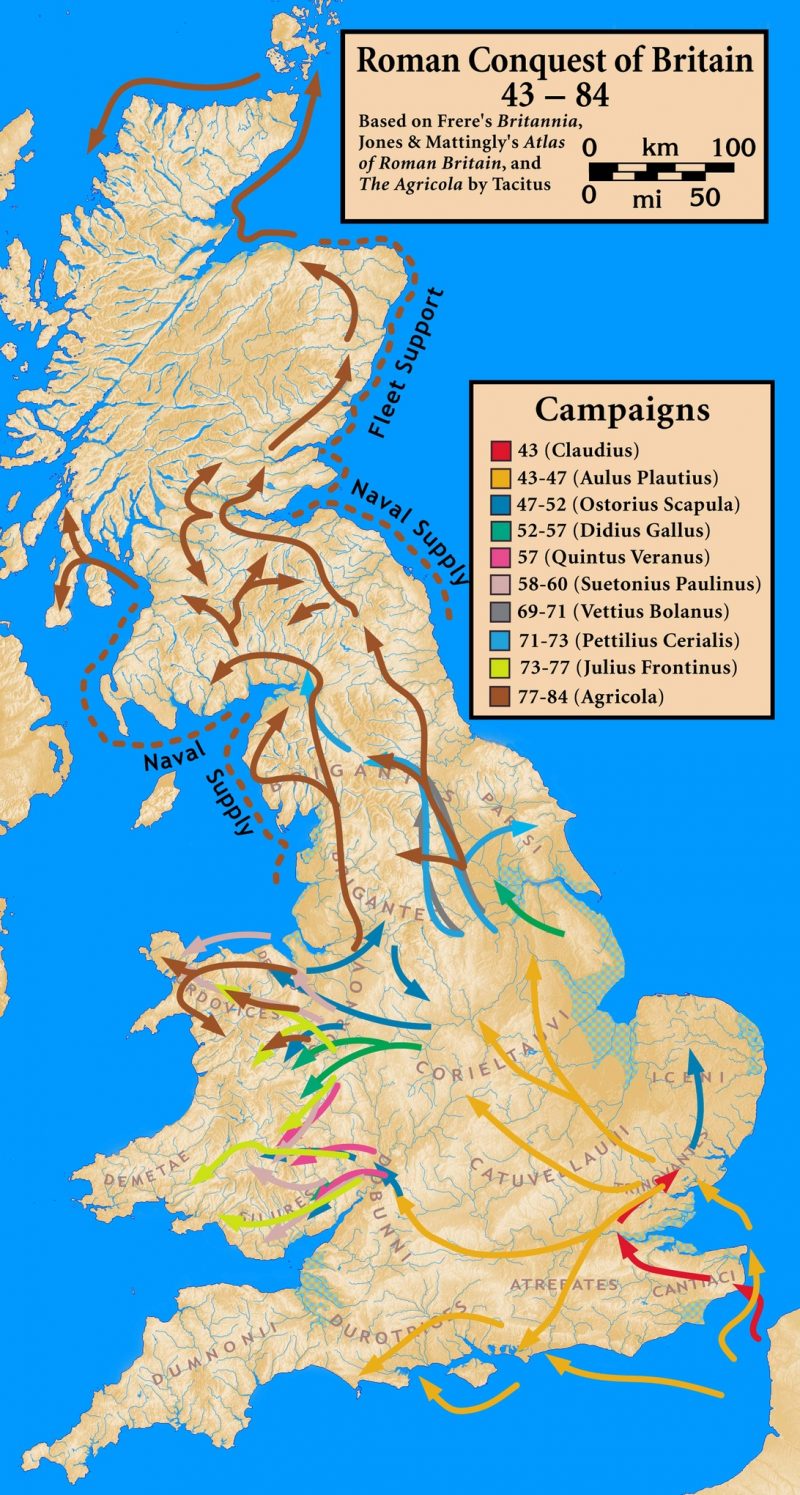
9. Emperor Constantine and the Christianization of the empire
After emperor Diocletian in 311 AD, the throne was won by Constantine. He became the sole emperor of Rome in 324 AD. Constantine made some drastic changes in the empire. First of all, he created a new capital at Byzantium and named it after himself, Constantinople. With this step, he laid the foundations for the Eastern Roman Empire. But, his biggest change was the change of the official religion of the Roman Empire. Constantine became the first Christian emperor. At the beginning, many of the subjects resisted this decision, but eventually things settled down. Because of this decision made by Constantine, Christianity became the dominant religion of Europe for the next 1,500 years.
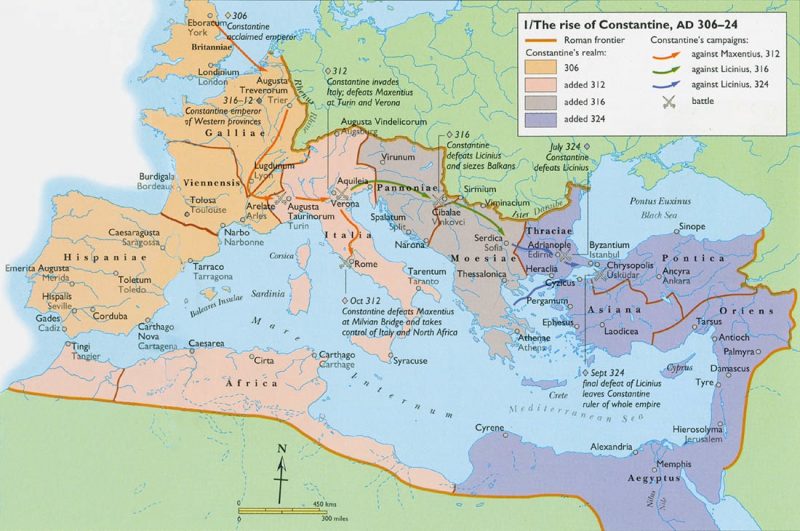
10. The Roman Empire gets divided between East and West
When Constantine died 337, the whole Roman Empire was divided among his three sons. They immediately began fighting between themselves. Fights like this will continue for the next 50 years and in this time it became clear that the empire became unfit to be ruled by one man. The last emperor that manage to hold the whole empire under control was Theodosius, and he died in 395 AD. By the year of 400 AD, it was almost impossible for a single emperor to gather big enough army which will protect that kind of vast territory that streched from Spain all the way to the Middle East.
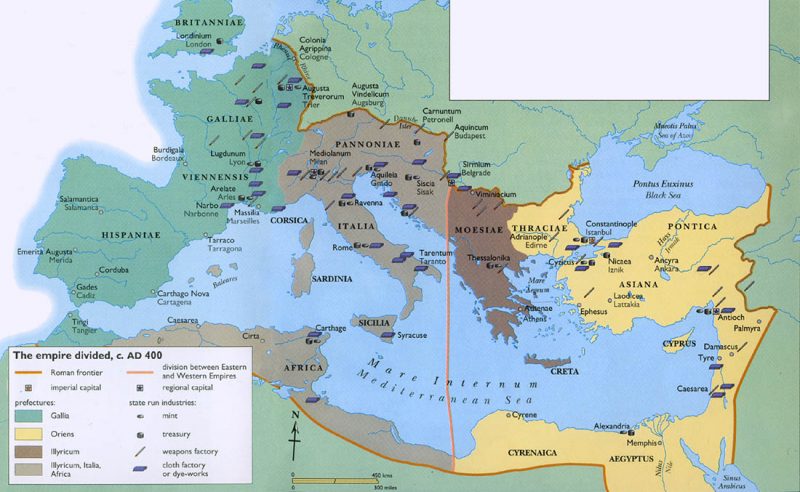
Source: vox